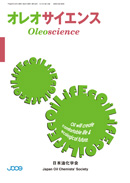
- |<
- <
- 1
- >
- >|
-
Shun SATO2014 Volume 14 Issue 4 Pages 141-147
Published: 2014
Released on J-STAGE: February 01, 2017
JOURNAL FREE ACCESSA global shift from petroleum-based materials to bio-based ones in chemical and energy industries leads to a significant increase in the use of plant oils and animal fats as raw materials for chemical products. Much attention has then been paid to the use of surplus raw glycerol by-produced in the industries. To address this matter, a biotechnological method to produce glyceric acid (GA) from glycerol was developed. However, for the practical use of GA, further applications of GA as well as improvement of the GA production process should be developed. This review summarizes recent research topics of application of GA to functional chemicals and improvement of the GA production process. For the GA application, GA calcium was found to activate ethanol-dosed gastric cells. It was also found that performace of monoacyl GA is superior to that of practical surfactants and that glucosyl GA functions as biomolecular protectants. As for the GA production process, effect of methanol in the raw glycerol derived from BDF industries on the GA production was investigated. By genomic, transcriptomic and enzymatic analyses, methanol was found to directly inhibit the enzymatic oxidation of glycerol. Further improvement of the process was performed by mutagenesis of GA-producing strain.
View full abstractDownload PDF (889K) -
Yoshimune NONOMURA2014 Volume 14 Issue 4 Pages 149-156
Published: 2014
Released on J-STAGE: February 01, 2017
JOURNAL FREE ACCESSSeveral interesting wetting phenomena occur on biological surfaces, e.g., super hydrophobic behavior of rough surfaces covered with wax crystals, collection of drinking water from fogladen wind through a condensation process, and surface tension-induced transport of prey in millimetric water droplets. Interfacial phenomena on hydrophilic rough surfaces coated with mucus such as the tongue and small intestine wall contribute to effective nutritional absorption or sensitization of the senses. However, there are few reports on the wetting phenomena on such surfaces owing to the difficulty of direct observations or physical evaluations. In this study, we prepared agar gels with fractal surfaces, which mimic the morphology and surface properties of biological surfaces, and used a new bio-surface model to observe the spreading behavior of liquids on the surfaces. Results of high-speed observation showed that the rough structure accelerated the spreading of water droplets and induced the appearance of a wicking front. Moreover, the addition of alcohol or colloidal particles induced the acceleration of wetting with Marangoni flow and the inhibition with assembling of particles. We have attempted to observe interfacial phenomena on biological interfaces and understand the fundamental laws of wetting dynamics. These findings can be applied to food, medical products, and cosmetic products.
View full abstractDownload PDF (1922K)
- |<
- <
- 1
- >
- >|